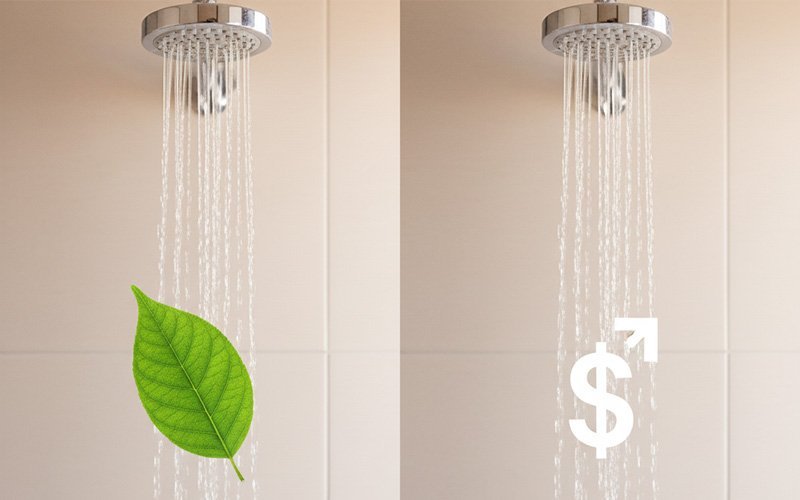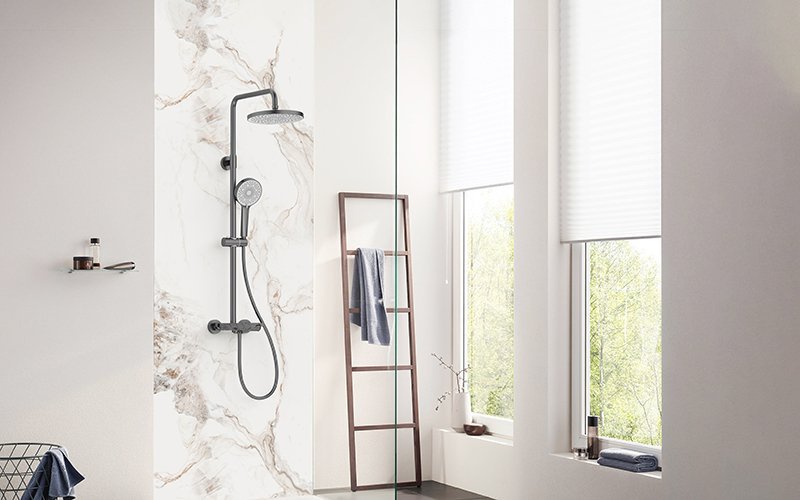
Taking a shower should be simple. But sometimes, you have to keep adjusting the knobs to get the water temperature just right.
It can be annoying when the water suddenly gets ice-cold or burning hot. This can happen when someone flushes a toilet or uses a sink somewhere else in the house.
A thermostatic shower system helps fix this problem. It’s a type of shower that automatically keeps the water at the temperature you set. This makes your shower more comfortable and safer for everyone, especially kids and older adults.
This guide will explain how these showers work, what types you can buy, and what you need to know before choosing one.
What is a Thermostatic Shower?
A thermostatic shower system is a shower fixture that automatically maintains a consistent water temperature by balancing the hot and cold water supplies.
It uses a thermostatic valve with a temperature-sensitive element that continuously monitors and adjusts the mix of hot and cold water to keep the temperature steady, even if water pressure or temperature fluctuates due to other household activities.
This system prevents sudden temperature changes, such as scalding or cold shocks, enhancing safety and comfort during showering.
Thermostatic showers typically feature separate controls for temperature and water flow, a safety stop to prevent excessively high temperatures, and an anti-scald mechanism that cuts off hot water if the cold water supply fails.
They are especially beneficial for families with children, elderly, or people with sensitive skin, as well as for providing a luxurious and consistent shower experience without the need to manually adjust the temperature constantly.
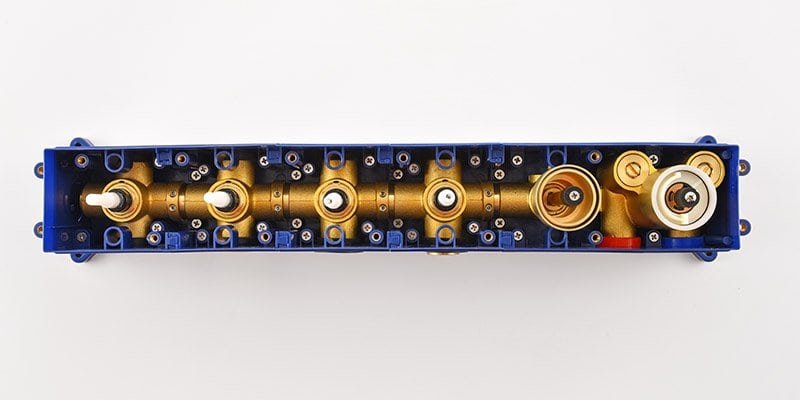
Section 1: How a Thermostatic Shower Valve Works
The “brain” of a thermostatic shower is a part called the Thermostatic Mixing Valve, or TMV. It’s a smart device inside your wall that mixes hot and cold water for you.
Unlike regular showers where you turn the knobs, a thermostatic valve does the work automatically. It keeps the water temperature steady, even if the water pressure changes in your house.
Inside the Valve
The valve works using simple mechanics, not electricity. This makes it reliable and quick to react.
A key part is a small wax piece inside the valve. This wax senses the water temperature. When the water gets hotter, the wax expands. When it gets cooler, the wax shrinks.
This expansion and shrinking moves a small gate, called a piston. The piston blocks or opens the flow of hot and cold water. If the water gets too hot, the piston moves to let in more cold water. If it gets too cold, it lets in more hot water.
This all happens in a fraction of a second, so you don’t even feel the temperature change.
A Built-in Safety Feature
The valve works using simple mechanics, not electricity. This makes it reliable and quick to react.
A key part is a small wax piece inside the valve. This wax senses the water temperature. When the water gets hotter, the wax expands. When it gets cooler, the wax shrinks.
This expansion and shrinking moves a small gate, called a piston. The piston blocks or opens the flow of hot and cold water. If the water gets too hot, the piston moves to let in more cold water. If it gets too cold, it lets in more hot water.
This all happens in a fraction of a second, so you don’t even feel the temperature change.
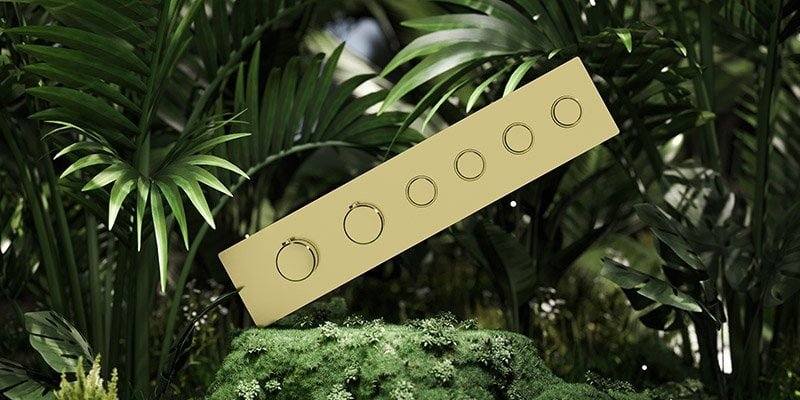
Section 2: Types of Shower Valves
When you remodel a bathroom, you’ll choose between a few types of shower valves. Understanding how they differ will help you pick the right one.
Valve Options
- Manual Mixer Valves: This is the most basic type of shower control. You have two handles, one for hot and one for cold, and you mix them yourself. They are simple and low-cost, but they don’t protect you from sudden temperature changes.
- Pressure-Balancing Valves: This is a more common type of valve today. It senses changes in water pressure. If someone flushes a toilet, the cold water pressure drops. The valve balances this by reducing the hot water pressure, so you don’t get scalded. However, it can’t adjust for changes in the water heater’s temperature.
- Thermostatic Valves: This valve controls the actual temperature of the water. You set the temperature you want, and the valve keeps it there. It protects you from changes in both water pressure and water temperature. It also lets you control the water flow and temperature with separate handles.
Shower Valve Comparison
| Feature | Manual Mixer Valve | Pressure-Balancing Valve | Thermostatic Valve |
|---|---|---|---|
| How it Works | You turn separate hot and cold knobs. | Balances water pressure to keep the temperature from suddenly changing. | Senses and controls the water temperature to keep it constant. |
| Main Benefit | Low cost and simple design. | Helps prevent scalding from pressure changes. | Keeps water at the exact temperature you set. |
| Temperature Control | You have to adjust it constantly. | Good, but can’t adjust if your water heater temperature changes. | Very precise. You can “set it and forget it.” |
| Volume Control | Usually has separate knobs. | Often tied to the temperature handle. | Has a separate handle, so you can save water without changing the temperature. |
| Safety | No protection from sudden temperature changes. | Protects from scalding caused by pressure changes. | Protects from scalding and has an automatic shutoff feature. |
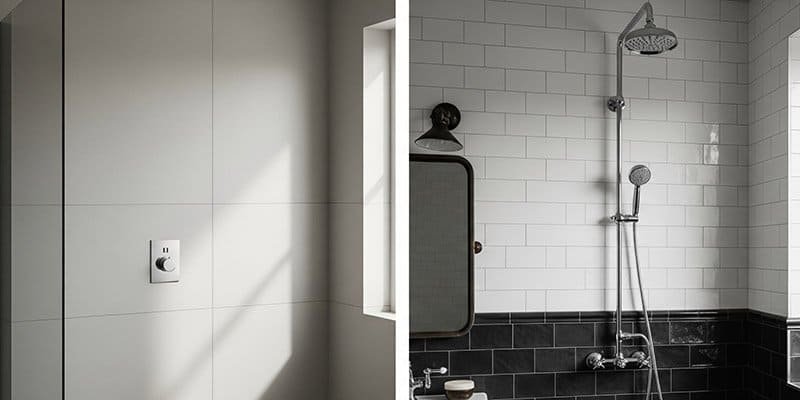
Section 3: Shower System Designs
After choosing the valve, you’ll decide how you want your shower system to look. The two main styles are concealed and exposed.
Concealed vs. Exposed Systems
- Concealed Shower Systems: In this style, the valve and pipes are hidden inside the wall. All you see is a neat control panel and the showerhead.
- Pros: It looks clean and modern. It also saves space, which is great for smaller showers.
- Cons: It’s harder and more expensive to install because the wall has to be opened up. Repairs can also be difficult.
- Exposed Shower Systems: With this style, the valve and pipes are mounted on the outside of the wall.
- Pros: It’s much easier and cheaper to install, making it a good choice for bathroom updates. Repairs are also simpler because everything is easy to get to.
- Cons: It takes up more space in the shower. There are also more parts to clean.
Adding More Shower Heads
Thermostatic systems are great for showers with more than one water outlet, like a spa. You can add different parts to create a custom experience.
A part called a diverter acts like a switch. It lets you send water to different outlets. For example, you can switch from the main showerhead to a handheld sprayer.
Some common outlets you can add are:
- Rainfall Showerheads: Large, flat showerheads that make you feel like you’re standing in the rain.
- Handheld Wands: A sprayer on a hose that makes it easy to rinse your hair or clean the shower.
- Body Jets: Small jets on the wall that spray water to massage your body.
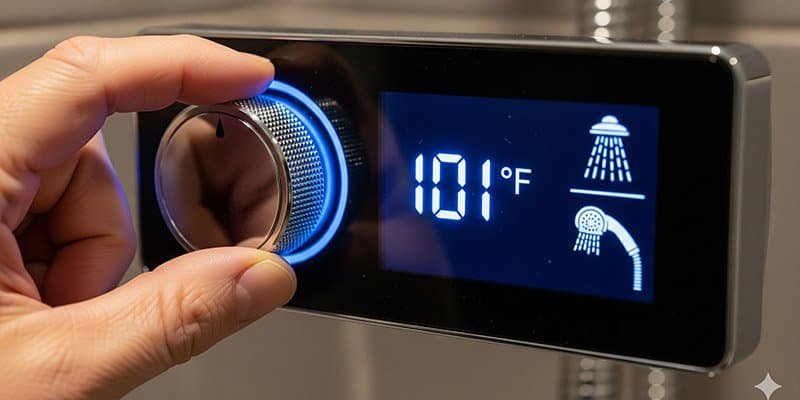
Section 4: Digital and Smart Showers
Shower technology now includes digital controls. These systems use buttons or a screen instead of knobs and offer more features.
Mechanical vs. Digital Controls
- Mechanical Controls: These are the standard knobs and levers that you turn by hand. They are simple, reliable, and easy to use.
- Digital Controls: These systems have an electronic control panel. The valve can be placed away from the shower, giving you more design freedom.
Features of Digital Showers
Digital showers offer some interesting features:
- Exact Temperature: You can set the water temperature to a specific degree.
- User Profiles: You can save settings for different people in your family.
- Remote Start: You can turn on the shower from your phone or with your voice so it’s warm when you get in.
- Warm-up and Pause: The shower warms up to your temperature, then pauses the water to save it until you’re ready.
- Water Usage Tracking: Some apps let you see how much water you’re using.
Are They a Good Choice?
Digital showers offer a lot of convenience. However, they are very expensive. They also need electricity to work, so they won’t function in a power outage.
Because the technology is still new, some users have reported problems with them not working correctly. For now, a good mechanical thermostatic system is often a more reliable choice.
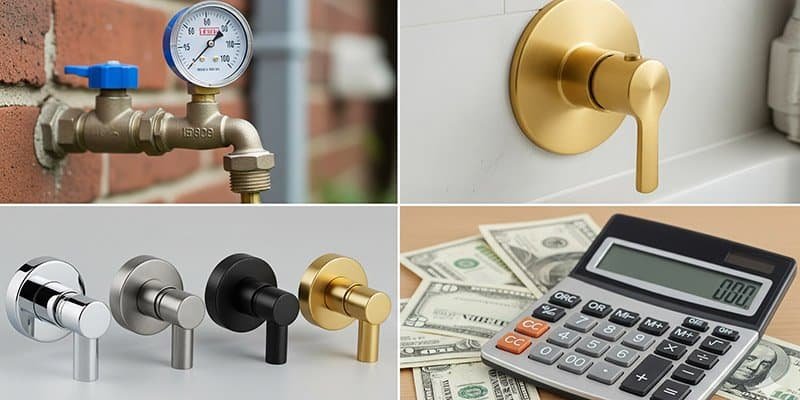
Section 5: What to Look For When Buying
Before you buy a thermostatic shower system, there are a few important things to check.
1. Water Pressure and Flow
Your home’s water pressure is very important. If the pressure is too low, your new shower might feel weak, especially if you have multiple showerheads.
- PSI (Pounds per Square Inch): This is the force of your water. Most homes have between 40 and 60 PSI.
- GPM (Gallons Per Minute): This is the amount of water that flows through your pipes.
2. Materials
Look for a shower valve made of solid brass. Brass is very strong and won’t rust or break down over time. Cheaper systems might use plastic or other metals that can crack and cause leaks inside your walls.
3. Finishes
The finish is the color and texture of your shower parts. It affects how your shower looks and how easy it is to clean.
- Polished Chrome: A shiny, mirror-like silver. It’s very popular but shows water spots easily.
- Brushed Nickel: A duller, soft silver. It’s great at hiding fingerprints and water spots.
- Matte Black: A flat black finish that looks modern. It doesn’t show fingerprints but can show dust.
- Brushed Gold: A soft gold color that gives a warm, elegant look.
- Oil-Rubbed Bronze: A dark brown color that looks rustic or traditional.
Shower System Finishes Compare
| Finish | Look | Cleaning Leve | Cost |
|---|---|---|---|
| Polished Chrome | Shiny, bright silver | High (shows spots) | Low |
| Brushed Nickel | Soft, dull silver | Low (hides spots) | Medium |
| Matte Black | Flat, modern black | Medium (hides fingerprints) | Medium to High |
| Brushed Gold | Soft, warm gold | Low to Medium | High |
| Oil-Rubbed Bronze | Dark, rustic brown | Medium | Medium to High |
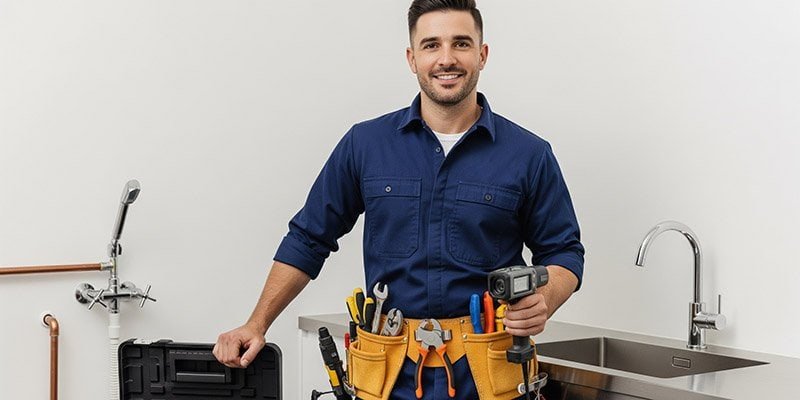
Section 6: Installation and Care
Proper installation and regular cleaning will help your new shower system work well for a long time.
DIY vs. Hiring a Professional
It might seem cheaper to install the shower valve yourself, but it can be risky. A small mistake can cause a leak inside your wall, which can lead to mold and expensive damage.
For most people, it’s best to hire a licensed plumber. A plumber has the right tools and experience. They can make sure the job is done correctly and according to local rules. This is especially important for concealed systems that go inside the wall.
Keeping Your Shower Clean
The biggest enemy of a shower valve is hard water buildup, also known as limescale. This can clog the valve and stop it from working correctly.
- Regular Cleaning: Wipe down the handles and showerhead with a soft cloth and mild soap.
- Cleaning the Showerhead: To clean a clogged showerhead, you can unscrew it and soak it in a bowl of white vinegar for a few hours. This will dissolve the mineral buildup.
- Cleaning the Valve: If your water temperature starts to act up, the inside of the valve (the cartridge) may need to be cleaned. A plumber can do this, or you can do it yourself by turning off the water, removing the cartridge, and soaking it in vinegar.
3. Finishes
The finish is the color and texture of your shower parts. It affects how your shower looks and how easy it is to clean.
- Polished Chrome: A shiny, mirror-like silver. It’s very popular but shows water spots easily.
- Brushed Nickel: A duller, soft silver. It’s great at hiding fingerprints and water spots.
- Matte Black: A flat black finish that looks modern. It doesn’t show fingerprints but can show dust.
- Brushed Gold: A soft gold color that gives a warm, elegant look.
- Oil-Rubbed Bronze: A dark brown color that looks rustic or traditional.
Shower System Finishes Compare
| Finish | Look | Cleaning Leve | Cost |
|---|---|---|---|
| Polished Chrome | Shiny, bright silver | High (shows spots) | Low |
| Brushed Nickel | Soft, dull silver | Low (hides spots) | Medium |
| Matte Black | Flat, modern black | Medium (hides fingerprints) | Medium to High |
| Brushed Gold | Soft, warm gold | Low to Medium | High |
| Oil-Rubbed Bronze | Dark, rustic brown | Medium | Medium to High |
Section 7: Conclusion
A thermostatic shower system is a great upgrade for any bathroom. It provides a safer, more comfortable, and more consistent shower every day.
To choose the right one, start by checking your home’s water pressure. Then, decide if you want a hidden (concealed) or visible (exposed) design.
Think about your needs:
- For Safety: A mechanical thermostatic system is a reliable choice for families with kids or elderly members.
- For a Big Remodel: A concealed system with multiple outlets can create a spa-like feel. Just be sure to plan with your plumber.
- For a Simple Upgrade: An exposed system is easy to install and can be a great way to get thermostatic control without redoing your whole bathroom.
- For Tech Lovers: A digital shower offers cool features, but be aware of the high cost and potential for issues.
By thinking about these points, you can choose a shower system that you’ll be happy with.
Related Posts



